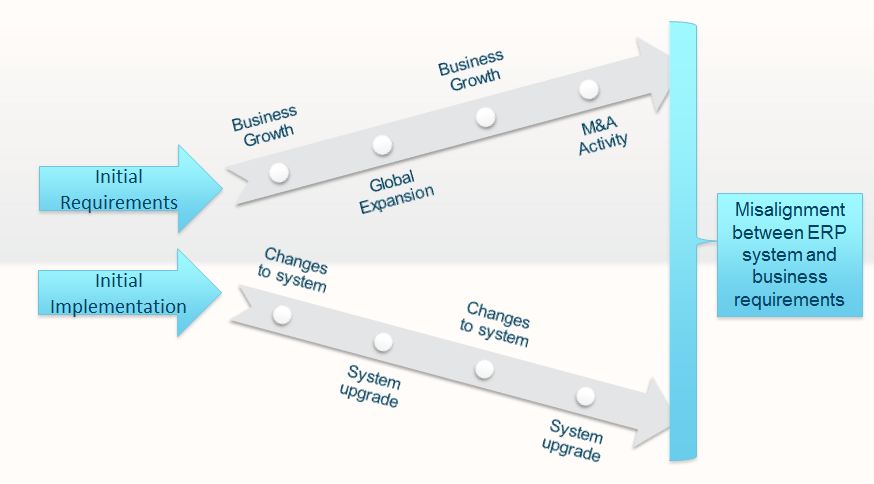Many companies have encountered speed bumps in their attempts to continue their organic growth. In order to mitigate these economic headwinds, a fair number of companies have turned to merger and acquisition activities to reignite stagnant growth caused by maturing markets and skittish customers.
While M&A activity can provide a strategic platform for future growth, it can also accelerate operational and enterprise software challenges. Even though most companies are likely to outgrow their ERP systems as they evolve over time, a merger or acquisition exacerbates and accelerates this natural occurrence. In these cases, you now have two companies that are different in many ways, including in their respective operating models and ERP systems. 
These risks don’t need to be a surprise or even disruptive to a merger or acquisition. Here are a few pieces of advice to help prepare for the potential challenges of combining entities . . . and ERP systems:
Standardize business processes first. While it may be tempting to jump into the “Which software are we going to keep for the combined entity?” discussion right away, it is important not to put the cart before the horse. In order to determine which systems will best support the merged organization, it is important to understand how the business is going to run going forward. Otherwise, the decision of which systems to keep and which to retire will be driven by internal politics and instead of tangible business requirements and needs. For example, a large portion of our client base request our assistance standardizing operations and facilitating business process reengineering before we ever start evaluating or implementing specific ERP systems.
ERP Selection Guide
This ERP Selection Guide will help you select technology that will support your organization for at least the next ten years.
Define the best ERP strategy for the new organization. To take even one step further back, it is equally important to define your overall ERP strategy going forward. How much will the two companies standardize operations? Will they remain independently operated? Will there be some areas that are shared across both organizations, such as HR or finance? These and other strategic decisions should be made well before premature discussions about ERP software.
Recognize that organizational change management will be even more difficult than with most ERP implementations. Regardless of the answers to the above two areas, we find with our recently merged clients that organizational change management is even harder than with most ERP implementations. In addition to “typical” enterprise software challenges, employees at combined entities have many unique stressors and sources of resistance, such as new roles and responsibilities, uncertainty related to job security, new reporting structures and a host of other issues that further complicate or even derail an “out-of-the-box” organizational change management initiative. An effective organizational change management program will account for these and other sources of organizational resistance.
Make the above process repeatable and scalable. It’s safe to assume this won’t be your last merger or acquisition. As a result, you should document standard business processes, develop a corporate ERP center of excellence and facilitate other activities that make merger integration much faster and more effective the next time around. Companies that employ this sort of mentality are more likely to have successful ERP implementations at their newly-acquired entities in the future.
Mergers and acquisitions are strategic maneuvers for long-term growth. However, ERP implementations are typically the last thing on executives’ minds when they head down this path. Panorama’s ERP consultants can ensure you’re prepared for the transition. We prepare you for the integration people, processes and disparate ERP systems.













